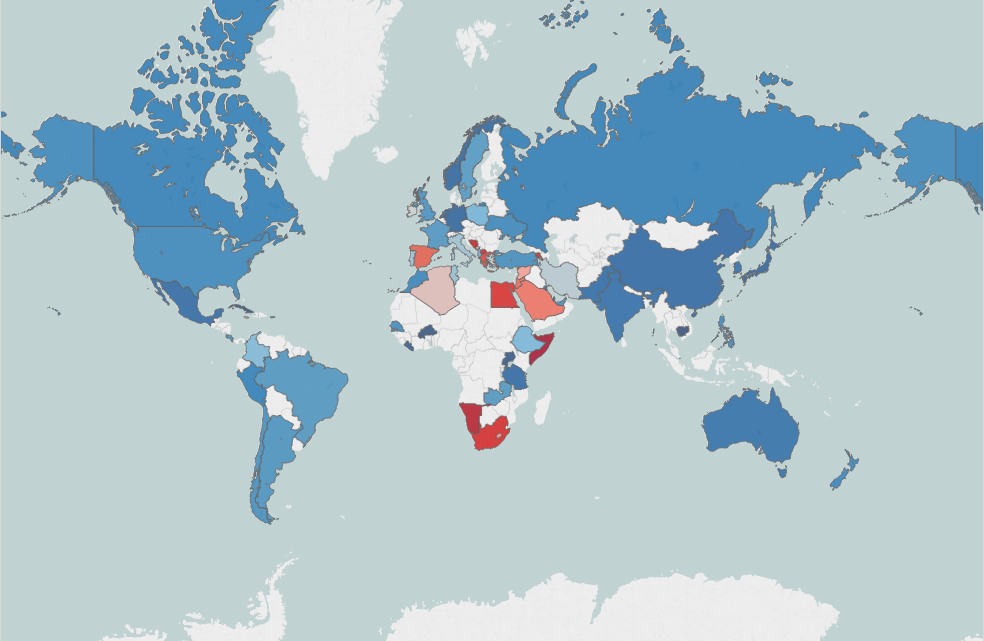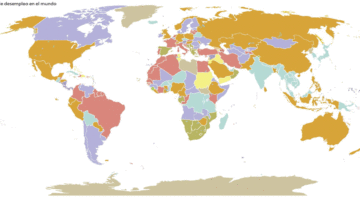
Youth unemployment is a problem that affects the entire world. More than 75 million young people aged 16 to 25 are unemployed or have serious difficulties in gaining access to the labour market according to ILO data. In the following lines, at the Youth Employment Decade (hereinafter YED), we would like to analyse the map in the header of this article based on texts that have already been published on the website and that may serve to further delve into this issue.
West Europe and North America
In a recent report, the ILO warned that countries with high youth unemployment are “especially vulnerable”. Far from correcting the situation, conditions have worsened since the crisis began. The figures, in Europe, are alarming. Of the 10 countries with the highest number of unemployed teenagers, 7 are European. Spain and Greece top the list with 50% unemployment rates. Both are striking cases because the since 2008, the economic situation has led many qualified youths to travel abroad in search of a better future. In the Greek case particularly, given the uncertainty surrounding the country, this trend has increased. Another Mediterranean country, such as Spain, is also going through serious problems regarding young people. Brussels warned the government in Madrid that the numbers did not tally and that if this high level of unemployment among young people persisted, the situation could become “unsustainable”.
Bosnia, Italy, Croatia… are also affected. The European institutions have tried to remedy this situation and, consequently, they tried to activate the Youth Guarantee in 2013; a provision of funds to EU Member States to curb the potential consequences. The amount totalled 6,000 million euros but the ILO estimated that 21,000 million euros would be needed at least to deal with this sever pandemic. Two years after its launch, the situation has hardly improved.
The situation is such that even Pope Francis I, when he addressed the European Parliament, mentioned youth unemployment and said that young people should not be socially excluded.
Young people in the United States are also affected. Furthermore, the Democratic candidates for the 2016 presidential elections have monopolised the issue of fighting against youth unemployment. Both Senator Sanders and the former Secretary of State Hillary Clinton have mentioned this issue on several occasions. The former placed emphasis on the situation of young African-Americans while the former first lady offered a plan based on tax credits for hiring young people.
Latin America and the Caribbean
The Old Continent is suffering from this harrowing problem but, on the other side of the Atlantic, young people are finding themselves in the same situation. For example, in Latin America and the Caribbean, in spite of not being able to analyse youth unemployment as a whole, it is a situation that most Latin American countries share. The New World must move from “concern to action” on this issue.
The youth unemployment rate in Colombia is 16%, a figure that has fallen in recent years thanks to the joint efforts of the Government and Civil Organisations. However, one of the on-going issues in this country and in Latin America in general is inequality. Particularly in rural areas, where the youth poverty index reaches 60% in the case of Colombia.
Uruguay, on the other hand, is one of the countries where they have tried to combat youth unemployment more actively with various laws that we have already mentioned at the YED. Young Uruguayans are finding support in the new law but there are still certain aspects by that need improving.
Peru has also tried to reduce the unemployment rate among young people but the law promoted by Humala’s government was strongly opposed by those affected and it was even criticised by the ILO.
In Panama youth unemployment triples the general figure and women are affected to a greater extent. The same can be said of the Dominican Republic where young people are finding closed doors when it comes to their first jobs and companies are asking for experience.
Africa
This is one of the continents with the youngest demographics and even greater potential. It is also a place where civil society has enthusiastically welcomed the International Campaign that we are promoting with. At YED, we have analysed several African countries. Not all of the ones we would have liked but we have come across instances of how young people are an important driving force in countries where they have some margin for action.
In Nigeria, young people form the majority in the country; they account for 60% of the total population, approximately 80 million young people. However, youth unemployment in Nigeria has reached the eye-watering figure of over 50%, 56 million young people do not have jobs or work in highly precarious conditions.
We have also seen the situation in Cameroon through the views of Ngwa Wilson Forbi, CEO of the Integrated Youth Volunteer Foundation (IYVF). In an interview with YED, he told us that he thought education was the keystone to everything.
Prince Israel Oreka from Helping Lives International commented, in an interview, that his organisation “is a passion that originated to put an end to poverty by empowering young people to transform their nations”. In addition, his knowledge of West Africa allowed us to learn a bit more about the concerns of this group in that region.
Once of the most unsettling cases in Africa is South Africa. Youth unemployment affecting people aged 15 to 34 has increased from 32.7% to 36.1% from 2008 to 2014. President Zuma has said that the battle against youth unemployment will be fought by means of an alliance between public and private agencies.
In the failed state of Somalia, the situation of young people is dramatic. In an article published in YED, we stressed that over half of the Somali population is under 18 years of age. However, the lack of an economy and, above all, the fragmentation that exists in the Horn of Africa has led to violence becoming one of the most important destabilizing elements.
In Tanzania, an estimated 800,000 young people join the labour market. Most young people do not have the necessary skills; the skills offered by young people do not match those required by the labour market. The result is skill mismatch. President Jakaya Kikwete ensured that guaranteeing decent and well-paid employment is the inspiration and desire of very Tanzanian, whether young or adult.
Finally, we analysed the situation in Egypt. Most young people decide to emigrate as many are placed between a rock and a hard place. In other words, between insecurity and unemployment.
Asia-Pacific Region
In this region we have mainly focussed on Arab countries. Arab nations are faced with one the greatest challenges of the twenty-first century. While the economic growth they have enjoyed in the past two decades has enabled them to envisage their financial potential in specific fields, such as oil and construction, the youth unemployment issue in one of the world’s youngest regions will be key to maintaining their political and social direction.
It must be noted that the Middle East and the north of Africa are two of the regions in the world with the youngest population. However, the employment situation of these young people is dramatic. Only one in three young Arabs is in the labour market and the youth unemployment rate stands at 25% in the region.
More specifically, the Moroccan population is increasing and getting younger, while their internal economy is not capable of meeting the demand for so many jobs. The private sector lacks the ‘muscle’ to provide young people with decent contracts.
In Lebanon, youth unemployment stands at around 24%, a figure that can clearly be improved according to the ILO expert. There few job-creating options in this region. This lack of employment can lead to phenomena, such as the Arab Spring in 2010.
The economy in South Korea is going full steam ahead. It has kept up the same cruising speed (a growth rate above 3%) for many years, which has enabled it to become the fourth regional power behind China, Japan and India. However, there is some unfinished business, such as the access of young people aged 15 to 29 to a job. The official figures place the youth unemployment rate at 10.2%, but some economists place it at 25%.
Indonesia is another country that the YED has analysed. One of the main barriers to youth employment lies in its inflexible legislation. The youth unemployment rate currently stands at 22% for people aged 15 to 24.














